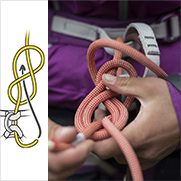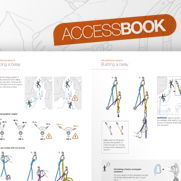Rope rescue: ASAP performance on a taut rope
Warnings
- Carefully read the Instructions for Use used in this technical advice before consulting the advice itself. You must have already read and understood the information in the Instructions for Use to be able to understand this supplementary information.
- Mastering these techniques requires specific training. Work with a professional to confirm your ability to perform these techniques safely and independently before attempting them unsupervised.
- We provide examples of techniques related to your activity. There may be others that we do not describe here.
When a victim is suspended on their work rope with an ASAP on their safety rope, certain rescue techniques allow the rescuer to use the victim's ropes for access. The rescuer installs a progression system on the victim's safety rope and an ASAP on the victim's work rope.
In case of mishandling, anchor failure, or rope failure during the victim access phase, one of the team members may fall. His/her ASAP must then stop the fall on a taut rope.
Accessing the victim from above.
The rescuer's ASAP is installed on the victim's work rope (rope 1). In case the rescuer descends too fast, or if rope 2 breaks, the rescuer's ASAP should lock onto rope 1, which is held taut by the victim's weight.
Accessing the victim from below.
The rescuer's progression system is installed on the victim's safety rope (rope 2).
In case rope 1 breaks, the victim's ASAP should lock onto rope 2, which is held taut by the rescuer's weight.
Note: in both situations, a secondary accident will complicate any rescue operations. Maximum precautions must be taken to avoid any anchor or rope failure while rescuing a team member. If the team member's ropes are unreliable, other ropes must be installed.
TESTS:
Tests carried out have shown that the ASAP works normally on a taut rope, without increasing the impact force and without damaging the rope.
Test 1:
100 kg mass, connected to the ASAP by an OK TRIACT without an energy absorber.
10.5 mm PARALLEL rope, tensioned by a 100 kg mass.
Start of the fall: ASAP at 1 m from the anchor, mass above the ASAP (fall of 2 times the length of the connector)
Result:
Rope intact / 3.2 kN impact force / ASAP displacement: 50 mm
Test 2:
100 kg mass, connected to the ASAP by an OK TRIACT + ABSORBICA L57 + VULCAN
10.5 mm PARALLEL rope, tensioned by a 100 kg mass.
Start of the fall: ASAP at 1 m from the anchor, mass above the ASAP (fall of 2 times the length of the energy absorber + connectors)
Result:
Rope intact (sheath very lightly marked) / 3.9 kN impact force / ASAP displacement: 50mm / ABSORBICA L57 tearing: 200 mm






